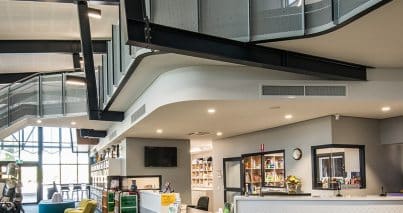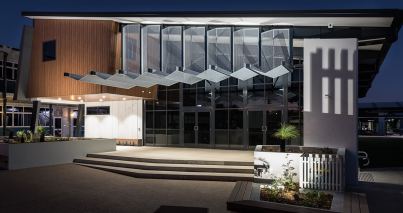Continuing on with the philosophy of ‘campus as city’ the library redevelopment at Mercy College sees the transformation of the existing single story library into a masterful civic building representing the heart and soul of the student city. The new library is setback from the alignment however, still addresses the street providing a landmark statement to Juliet Street and the wider community.
The existing Library was the last of the college facilities to be upgraded following the introduction of year seven students in 2015. Due to the increase in student numbers the library was required to be enlarged by 180m2. The landlocked nature of the site and the increased student numbers meant that outdoor areas within the campus were precious therefore enlarging the library required a vertical extension to the building.
The design solution was to retain the slab of the existing library and bridge over the top with a new two-storey portal frame structure that suspends a mezzanine level below on the southern side of the building. The southern facade of the building is canted to the north to increase the aperture to the sky and maximise daylight into the narrow divide between the new library and adjacent two-storey classroom building. Similar to the public face of the Administration building, full height, masonry walls articulate the northern façade of the building and reinforce the scale of the building and its civic hierarchy on the campus. The ample amount of aluminium framed glazing allows the building to be flooded with natural light and provides a permeability and transparency connecting the internal spaces to the surrounding school environment. The sometimes harsh tropical sun is veiled by perforated aluminium screens externally that fold and stretch to provide shading to the eastern curtain wall and concourse.
The modern library within a school has developed from a storage room for books and into a dynamic, flexible and adaptive space that supports many different modes of teaching and learning. The redeveloped Mercy library will be known as the Resource Centre and the internal planning and arrangement supports a multi-use facility. Both the ground floor and the mezzanine levels provide a range of different scale spaces that allow for the gathering of whole class groups, small works groups and even individual study. The concept of transparency and permeability is continued throughout the interior design through the clever interconnectivity of the different work areas levels within the building as well as the use of perforated aluminium for the mezzanine balustrading.
In summary the redevelopment of the Mercy Library successfully incorporates the following design principles;
- Learning spaces designed around people – support the teacher and engage the student by creating spatial environments that teachers and students want to be in. The spaces are comfortable, welcoming, connected and enjoyable.
- Support multiple types of learning activities – flexible spaces that allow for easy manipulation of furniture and spaces to support different teaching / learning modalities.
- Enable connections, inside and outside – every square meter of space have been considered in enabling learning.
- Accommodate information technology – considered technologies brought into space rather than built into space.
- Design for comfort, safety and functionality – all spaces are fit for purpose and understand the make-up (age and development level) of the various cohort groups within a secondary college.
- Reflect institutional values – create environments that encourages a community heart and promotes faith and life integration.
- Develop the role of the Library as the central ‘hub’ of the campus – a space that promotes connected learning experiences beyond information.





























